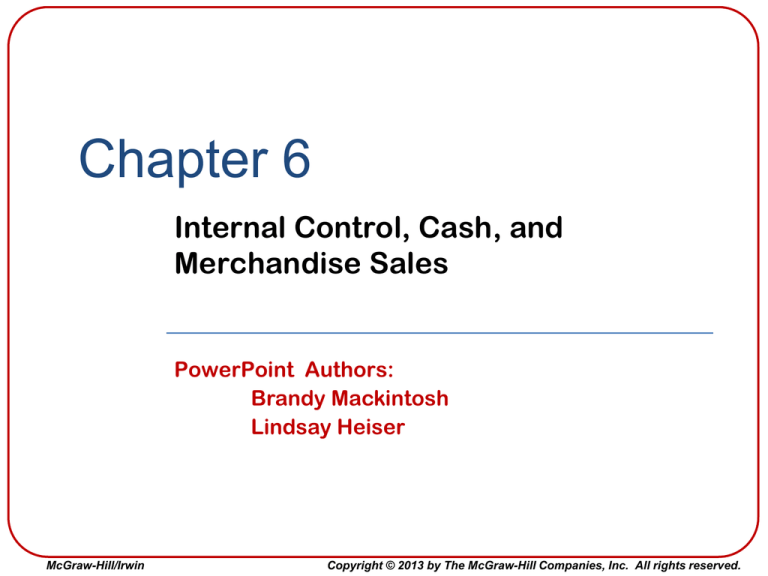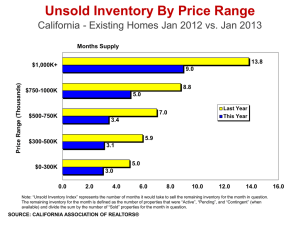
Chapter 6
Internal Control, Cash, and
Merchandise Sales
PowerPoint Authors:
Brandy Mackintosh
Lindsay Heiser
McGraw-Hill/Irwin
Copyright © 2013 by The McGraw-Hill Companies, Inc. All rights reserved.
Learning Objective 6-1
Distinguish among service,
merchandising, and
manufacturing
operations.
6-2
Operating Cycles
6-3
Operating Cycles
Sell
Products
Make
Products
Buy Raw
Materials
6-4
Manufacturing
Company
Incur
Operating
Expenses
Collect
Cash
Learning Objective 6-2
Explain common principles
and limitations of internal
control.
6-5
Internal Control
All companies include as part of their operating
activities a variety of procedures and policies that
are referred to as internal controls.
6-6
Internal control is important to all types and sizes of organizations,
especially after the business failures and accounting scandals
involving Enron and other companies in the early 2000s.
The Sarbanes-Oxley (SOX) Act requires all public companies to
assess the effectiveness of internal controls over financial reporting.
Effective internal controls play an essential role in creating an ethical
business environment, improving financial performance, and
preventing fraud.
Common Control Principles
6-7
Control Limitations
Internal controls can never
completely prevent and detect
errors and fraud.
Benefits vs. Cost
6-8
Human Error or
Fraud
Learning Objective 6-3
Apply internal control
principles to cash receipts and
payments.
6-9
Controlling and Reporting Cash
Internal control of cash is important
to any organization.
Volume of cash
is enormous.
6-10
Cash is valuable
and “owned” by
person
possessing it.
Cash Received in Person
Segregate Duties
Cashier
Recording
Custody
6-11
Cash Received in Person
6-12
Cash Received from a Remote
Source
Cash Received
by Mail
Cash Received
Electronically
6-13
Cash Payments
Cash Payments
Writing a
Check
Electronic
Funds
Transfer
A voucher
system
is acash
process
foremployees
approving
Most
companies
pay
to their
and
documenting
all purchases
through
EFTs, which
are knownand
by
payments
account.
employees
as on
direct
deposits.
6-14
Learning Objective 6-4
Perform the key control of
reconciling cash to bank
statements.
6-15
Bank Procedures and
Reconciliation
Banks provide services that help businesses to
control cash in several ways:
Restricting
Access
Documenting
Procedures
Independently
Verifying
A bank reconciliation is an internal report
prepared to verify the accuracy of both the
bank statement and the cash accounts of a
business or individual.
6-16
Bank Statement
6-17
Reconciling Differences
6-18
Bank Reconciliation
To determine the appropriate cash
balance, these balances need to be
reconciled.
6-19
Bank Reconciliation
Bank Reconciliation Goals
1.Identify the deposits in transit.
2.Identify the outstanding checks.
3.Record other transactions on the bank statement.
4.Determine the impact of errors.
6-20
Bank Reconciliation
6-21
Reporting Cash and Cash
Equivalents
Cash includes money or any
instrument that banks will accept for
deposit and immediate credit to a
company’s account, such as a check,
money order, or bank draft.
Cash equivalents are short-term, highly
liquid investments purchased within
three months of maturity.
6-22
Learning Objective 6-5
Explain the use of a perpetual
inventory system as a control.
6-23
Controlling and Reporting
Merchandise Sales
Inventory
Quantities
6-24
Inventory
Costs
Financial
Statements
Unsold
Inventory
Balance
Sheet
Sold
Inventory
Income
Statement
Perpetual Inventory System
In a perpetual inventory
system, the inventory
records are updated
“perpetually,” that is, every
time inventory is bought,
sold, or returned. Perpetual
systems often are combined
with bar codes and optical
scanners.
6-25
Periodic Inventory System
In a periodic inventory system,
the inventory records are updated “periodically,”
that is, at the end of the accounting period. To
determine how much merchandise has been sold,
periodic systems require that inventory be
physically counted at the end of the period.
6-26
Inventory Control
6-27
Perpetual
Inventory
System
Periodic
Inventory
System
Continuous
Tracking
No Up-to-Date
Records
Can
Estimate
Shrinkage
Can’t
Estimate
Shrinkage
Learning Objective 6-6
Analyze sales transactions
under a perpetual inventory
system.
6-28
Sales Transactions
Merchandisers earn revenues by transferring
ownership of merchandise to a customer, either
for cash or on credit.
For a merchandiser who is shipping goods to a
customer, the transfer of ownership occurs at one of
two possible times:
1. FOB shipping point —the sale is recorded when the
goods leave the seller’s shipping department.
2. FOB destination —the sale is recorded when the
goods reach their destination (the customer).
6-29
Sales Transactions
Every merchandise sale has two components,
each of which requires an entry in a perpetual
inventory system.
Selling
Price
Cost
6-30
Sales Transactions
Assume Wal-Mart sells two Schwinn mountain bikes for $400 cash. The bikes had
previously been recorded in Wal-Mart’s Inventory at a total cost of $350.
1 Analyze
Assets
Cash
Inventory
2
Liabilities
+$400
-$350
+
Stockholders’ Equity
Sales Revenue (+R) +$400
Cost of Goods Sold (+E) -$350
Record
dr
dr
6-31
=
Cash (+A)
cr Sales Revenue (+R, +SE)
Cost of Goods Sold (+E, -SE)
cr Inventory (-A)
400
400
350
350
Sales Returns and Allowances
When goods sold to a customer arrive
in damaged condition or are otherwise
unsatisfactory, the customer can
(1) return them for a full refund or
(2) keep them and ask for a reduction in
the selling price, called an allowance.
6-32
Sales Returns and Allowances
Suppose that after Wal-Mart sold the two Schwinn mountain bikes, the customer
returned one to Wal-Mart. Assuming that the bike is still like new, Wal-Mart would
refund the $200 selling price to the customer and take the bike back into inventory.
1 Analyze
Assets
2
Cash
-$200
Inventory
+$175
Liabilities
+
Stockholders’ Equity
Sales Returns and
Allowances (+xR) -$200
Cost of Goods Sold (-E) +$175
Record
dr
dr
6-33
=
Sales Returns & Allowances (+xR, -SE)
cr Cash (-A)
Inventory (+A)
cr Cost of Goods Sold (-E, +SE)
200
200
175
175
Sales on Account and Sales
Discounts
A sales discount is a sales price reduction
given to customers for prompt payment of
their account balance.
6-34
Sales on Account and Sales
Discounts
Suppose Wal-Mart’s warehouse store (Sam’s Club) sells printer paper on account
to a local business for $1,000 with payment terms of 2/10, n/30. The paper cost
Sam’s Club $700.
1 Analyze
Assets
=
Liabilities
Accounts Receivable+$1,000
Inventory
-$700
2
Stockholders’ Equity
Sales Revenue (+R) +$1,000
Cost of Goods Sold (+E) -$700
Record
dr
dr
6-35
+
Accounts Receivable (+A)
cr Sales Revenue (+R, +SE)
Cost of Goods Sold (+E, -SE)
cr Inventory (-A)
1,000
1,000
700
700
Sales on Account and Sales
Discounts
To take advantage of this 2% discount, the customer must pay Wal-Mart within 10
days. If the customer does so, it will deduct the $20 discount (2% $1,000) from the
total owed ($1,000), and then pay $980 to Wal-Mart.
1 Analyze
Assets
=
Liabilities
Cash
+$980
Accounts Receivable -$1,000
2
+
Stockholders’ Equity
Sales Discounts (+xR)
Record
dr
dr
980
20
Cash (+A)
Sales Discounts (+xR, -SE)
cr Accounts Receivable (-A)
1,000
(2% × $1,000)
6-36
-$20
Summary of Sales-Related
Transactions
The sales returns and allowances and sales
discounts introduced in this section were
recorded using contra-revenue accounts.
6-37
Learning Objective 6-7
Analyze a merchandiser’s
multistep income statement.
6-38
Gross Profit Percentage
Gross
Gross Profit
=
× 100
Profit %
Net Sales
6-39
Comparing Operating Results
Across Companies and Industries
6-40
Chapter 6
Solved Exercises
M6-10, M6-19, E6-5, E6-7, E6-10,
E6-17
McGraw-Hill/Irwin
Copyright © 2013 by The McGraw-Hill Companies, Inc. All rights reserved.
M6-10 Calculating Shrinkage in a Perpetual Inventory System
Corey’s Campus Store has $4,000 of inventory on hand at the
beginning of the month. During the month, the company buys $41,000
of merchandise and sells merchandise that had cost $30,000. At the
end of the month, $13,000 of inventory is on hand. How much
shrinkage occurred during the month?
Beginning inventory
Purchases
Cost of Goods Sold
Ending balance
Inventory count
Shrinkage
6-42
$ 4,000
+41,000
-30,000
15,000
-13,000
$ 2,000
M6-19 Calculating the Impact of Changes in Gross Profit
Percentage on Operating Income
Luxottica Group, the Italian company that sells Ray Ban and Killer Loop
sunglasses, reported a gross profit percentage of 66.4 percent in 2008
and 65.4 percent in 2009. In each of these two years, the company’s
net sales was fairly steady at approximately 5 million euro. Assuming
that Luxottica’s operating expenses were 2.6 million euro in each year,
how much more (or less) income from operations did Luxottica report in
2009 than in 2008?
Sales
Gross profit percentage
Gross Profit
Operating Expenses
Income from Operations
2008
€5,000,000
x 0.664
3,320,000
2,600,000
€ 720,000
Luxottica earned € 50,000 less in 2009 than 2008.
6-43
2009
€5,000,000
x 0.654
3,270,000
2,600,000
€ 670,000
End of Chapter 6
6-44








